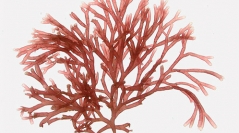

 Cryptogamie, Algologie
26 (2) - Pages 155-164
Cryptogamie, Algologie
26 (2) - Pages 155-164Scinaia chinensis (Tseng) Huisman, a little-known member of the Galaxauraceae, was recently collected from northeastern Taiwan. The carposporophyte development of this species is documented in detail and its taxonomic position is discussed. Colourless utricle cells are present in the cortex of older branches and 1-2 pigmented spherical monosporangia arise terminally from stalk-like outer cortical cells. Carpogonial branches consist of three cells: the carpogonium bearing a long trichogyne, the hypogynous cell bearing two one-two celled sterile branches, and the basal cell. After presumed fertilization, the basal cell produces 4-5 sterile branches that grow to form an involucre/pericarp. The fertilized carpogonium cuts off two gonimoblast initials, which develop further radially. The pit plugs between hypogynous cell, basal cell and inner gonimoblast cells break down and a large fusion cell forms at the base of the carposporophyte at maturity. After comparing Scinaia chinensis to other species of Gloiophloea and Scinaia, we conclude that it is well distinguished from Gloiophloea and displays closer affinities to the members of Scinaia, based on the presence of colorless utricles and the fact that there are only two sterile branches borne on the hypogynous cell. These observations, therefore, support the transfer of Gloiophloea chinensis Tseng to Scinaia chinensis (Tseng) Huisman.